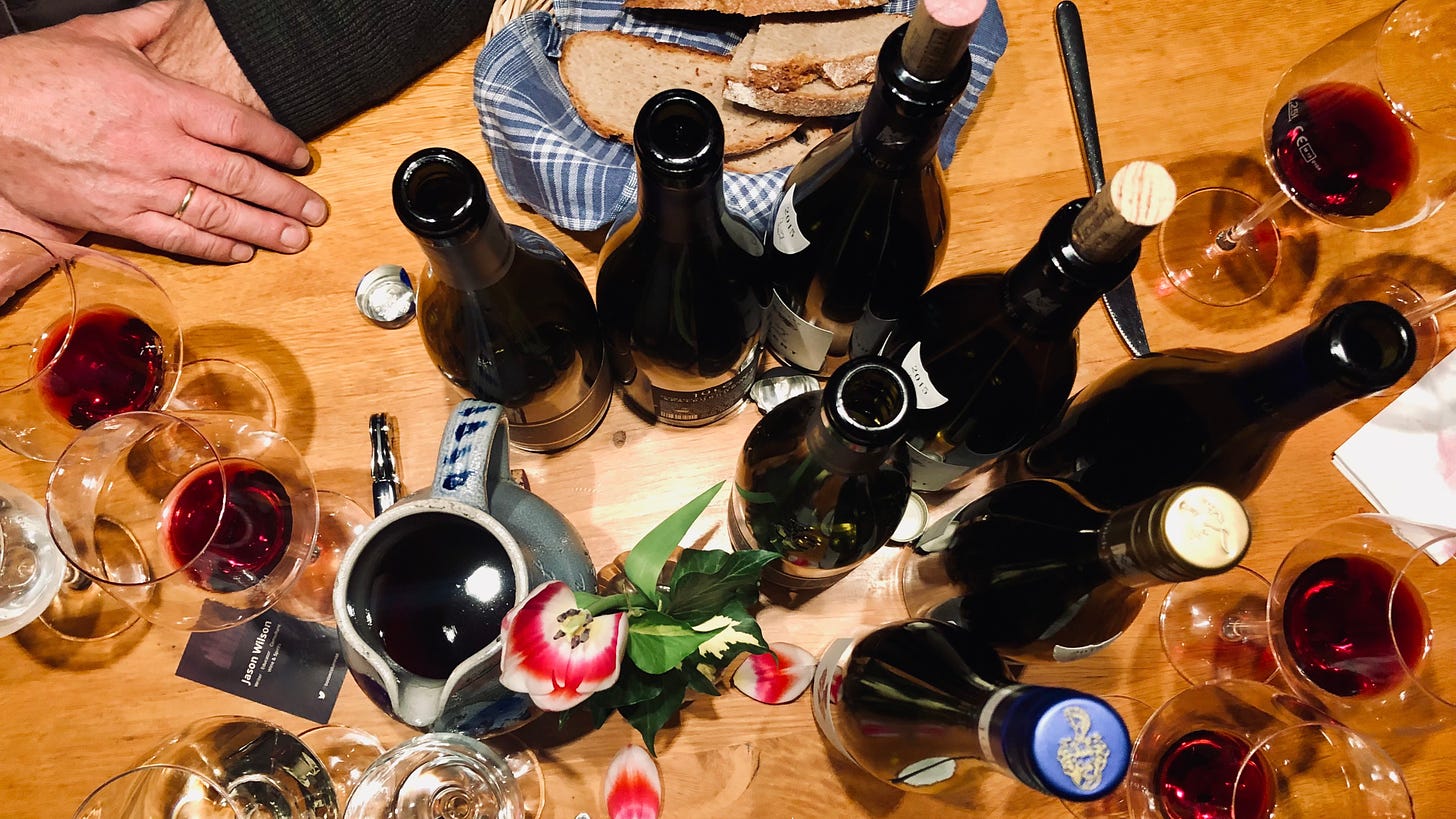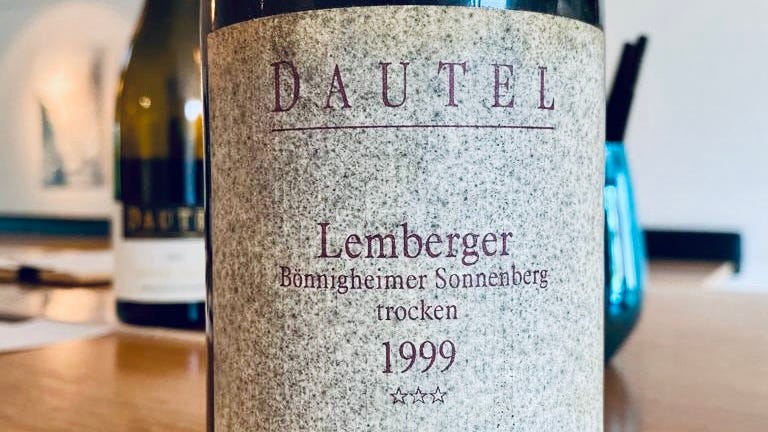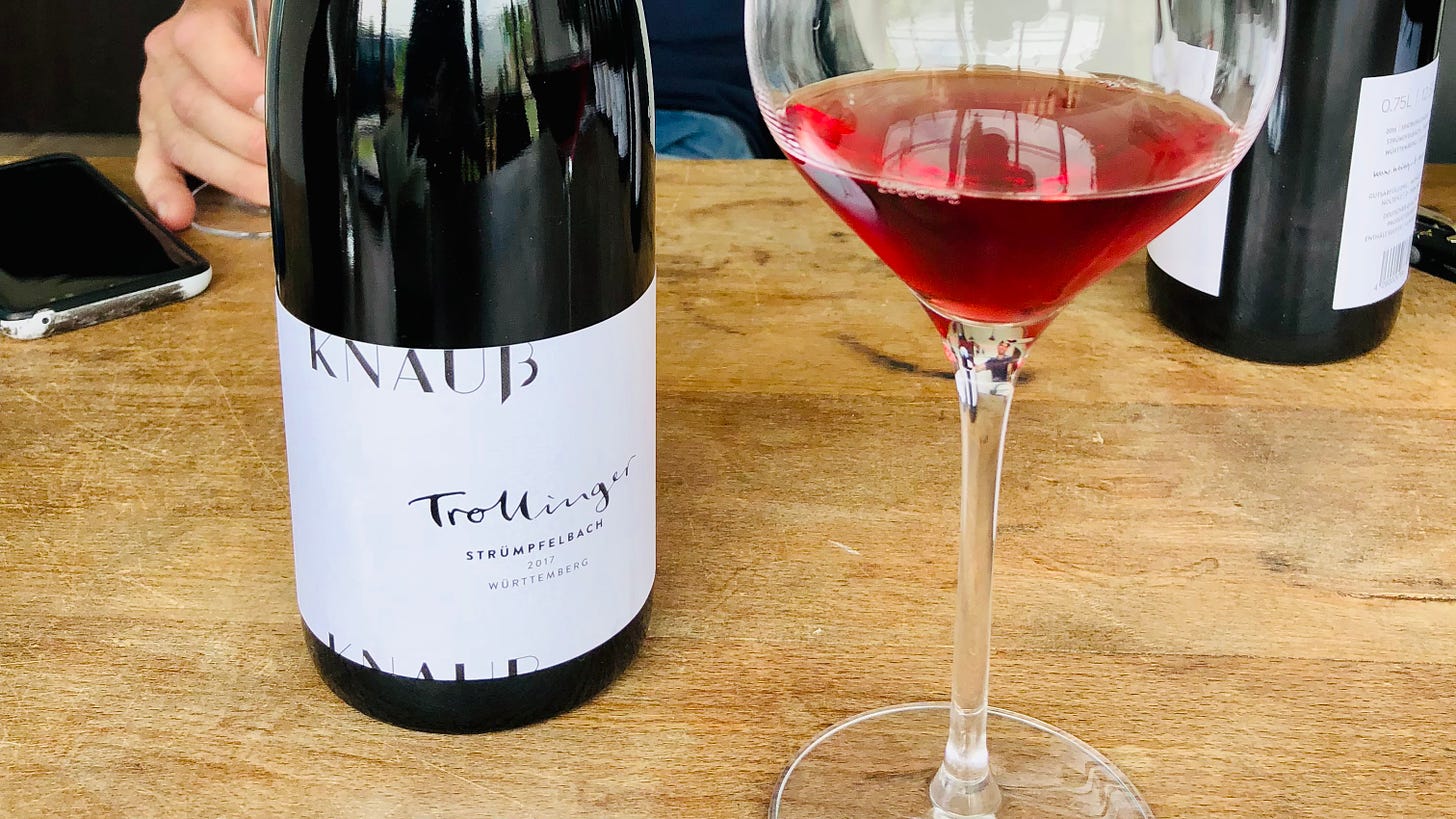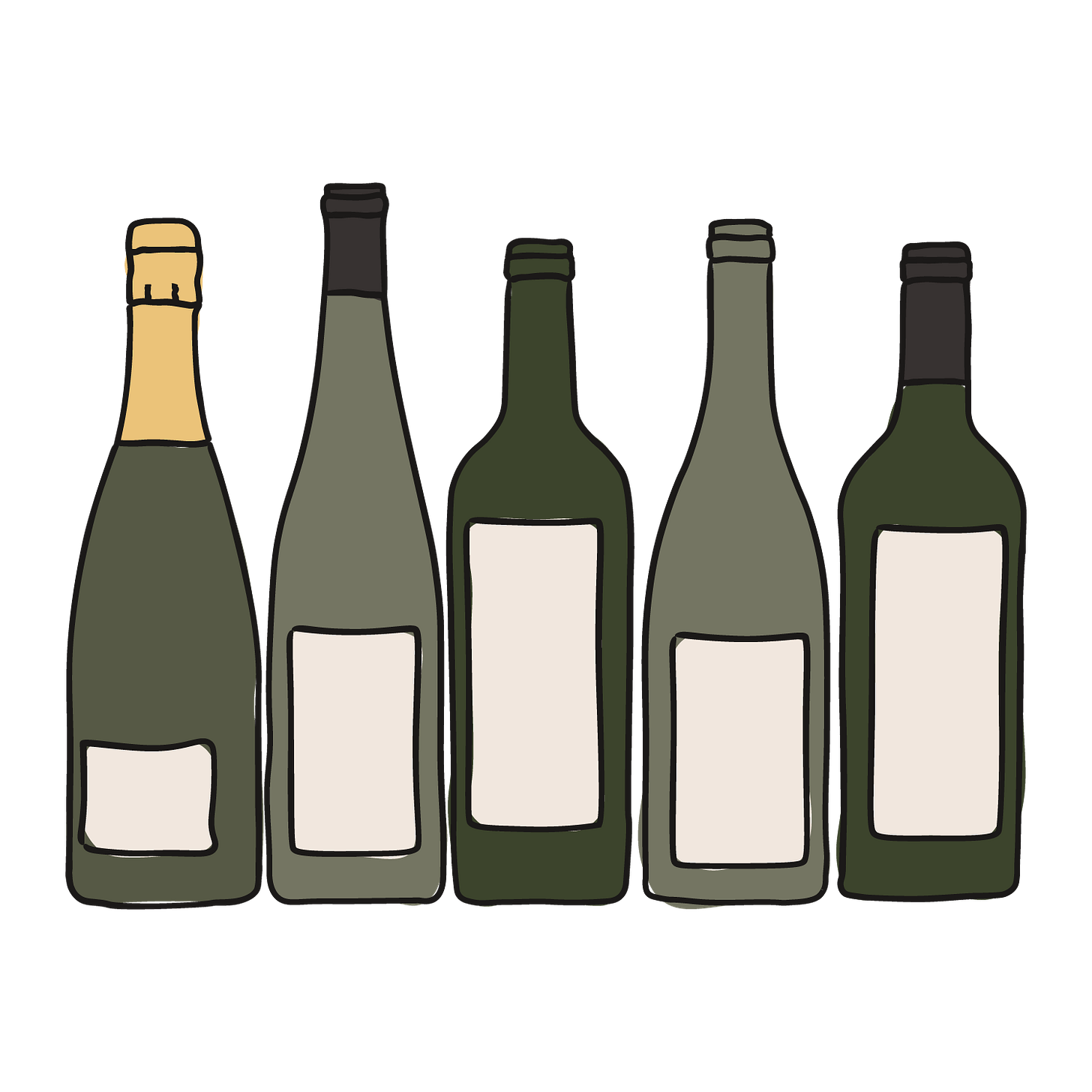What's German for Pinot Noir?
Spätburgunder? Yes yes, there's a different word for everything.

This is part two of the German wine trilogy. ICYMI here are part one and part three..
As he spoke at the start of the VDP Weinbörse tasting in Mainz, journalist and historian Daniel Deckers took attendees back in time—to the turn of the 21st century—to illustrate how far German wine had come in a just a few decades. Back then, he said, “there were very few dry wines and very few red wines.” He showed us an actual German advertisement from the late 20th century that suggested dry wines would be good to serve to diabetics. About the reds, Deckers said: “If you look at the history of German red wines, you wouldn’t see much that would encourage you.”
Fast forward to today, and the red wine from regions like Württemberg, Pfalz, or Ahr is in another league. Germany is now the world’s third-largest producer of pinot noir—which the Germans call spätburgunder. (Pinot = burgunder; we’ll deal with weissburgunder and grauburgunder on Thursday).
Honestly, I was skeptical of German pinot noir for a long time, but the overall quality, consistency, and style—especially in the $20-30 range—has won me over. Nearly every wine region in the world tries to channel its “inner Burgundy” and attempts to make pinot noir. Too often, what you get are overpriced, oaky, jammy, raspberry-juice bombs.
Good spätburgunder always has some earthy, savory notes underlying the fruit. “German pinot noir is getting better and better,” says Kerstin Kranz of Weingut Kranz. “We’ve learned how to make a fresh pinot noir, not the old fat style.” Spätburgunder (SHPAYT-bur-GUHN-der) is a much better value than much of what’s coming from, say, Oregon. But as with all German wines, we just need to see more of them in the U.S.
So how has a place known best for cool-climate whites become known for pinot noir? Climate is one reason. Germany is one of the few winners from the earth’s climate change crisis. Grapes can reach a ripeness they simply couldn’t in the past. “Our professors in school told us, ‘Pay attention to pinot noir, because you are now receiving the climate that made Burgundy famous,’” said Franz Wehrheim of Weingut Dr. Wehrheim in Pfalz. “We can invest in pinot noir in a way that no generation before was able to.”
Another factor is the ever-growing demand from German wine drinkers for red wines. Pfalz winemaker Hansjörg Rebholz of Ökonomierat Rebholz said that Germans now expect a lot from their pinot noirs. “We have a chance now because Burgundy is too expensive,” Rebholz said. (You may have heard about Burgundy’s rising prices before?)
Others are still hesitant to place their spätburgunder head-to-head against Burgundy. “I don’t think our pinot noir tastes like Burgundy, it’s something completely different,” said winemaker Moritz Haidle of Weingut Karl Haidle in Württemberg.
“It’s hard to say what a German pinot noir is because there are so many,” said Christian Dautel of Weingut Dautel in Württemberg. “It’s impossible to define a German pinot noir.”
But pinot noir is not the only red grape in Germany that I’m excited about. I also am big fan of lemberger—the same grape they call blaufränkisch in Austria. If you’ve read my work over the years, you know my deep affection for blaufränkisch. It was one of the grapes singled out in wine critic Robert Parker’s infamous “godforsaken grapes” rant that provided the kernel of my own book.
Lemberger is mostly grown in Württemberg. There, it’s different than Austrian blaufränkisch—particularly from Burgenland, where good, ageworthy examples can often take on similar characteristics to nebbiolo. In Württemberg, along the valleys of the Neckar River, lemberger veers more towards northern Rhône syrah in style. “Lemberger shouldn’t be a big-boy red wine, but compared to pinot noir there’s more intensity,” Dautel said.
Dautel and I spent a rainy morning in his steep vineyards (see video below) and then did a deep tasting of lemberger, including both the 2018 and 2019 of Sonnenberg and Michaelsberg (his Grosses Gewächs) as well as a 2011 Michaelsberg that had aged beautifully, with savory notes of tomato, olive, and dried herb that reminded me of older Loire reds. But the showstopper was a beautiful 1999 Sonnenberg, with incredible aromas of dried flowers, grilled herbs, and dark underlying notes of asphalt and licorice that carried through a finish that went for miles. Yeah, still thinking about that one.
I absolutely love these wines. And not just from Dautel. I also tasted amazing lemberger from Karl Haidle, Drautz-Able, and Graf Neipperg. Würrtemberg as a red-wine region is for real. Importers, I beseech you bring more of it into the U.S..
So why can we not get more? For sure, the Trump tariffs hurt German wines in general. But can that be the only reason? Dautel’s importer literally does not have a single bottle of his lemberger on their website. Dautel told me there’s a simple reason: “The wine is mostly drunk here. There’s a big market at our cellar door.” Württemberg, he said, has the highest consumption of wine per capita in Germany.
It’s also a wealthy region, with companies such as Mercedes and Porsche driving economic success. People have the money to afford good wines. It was actually shocking how close some top Württemberg vineyards are to urban centers and industry. One of Dautel’s GG vineyards overlooks a busy amusement park. One afternoon, on my way from Stuttgart to a winery, I passed the Porsche headquarters at what appeared to be closing time. I quickly became stuck in a traffic jam, surrounded by Porsches.
One other red grape from Germany we are seeing more of is trollinger—which is called either schiava or vernatsch in the Italian region called either Alto Adige or Südtirol (yes! wine names and places can be very confusing!). Trollinger is a very light red, low in alcohol and almost rosé in color, though with a little more backbone than most rosé. Dautel insists trollinger is “not a serious red wine” and “was drunk in Württemberg for breakfast and lunch”—which frankly sounds delightful.
I have done my best (below) to source some of German reds I tasted. Too many are only available in Europe, or even only in Germany. If any subscribers have intel on bottle shops with good German selections, please let’s get a thread going.
Seeking out the Spätburgunder? Looking for the Lemberger?
WÜRTTEMBERG
2019 Dautel Estate Spätburgunder, $24
Excellent value pinot: earthy, savory nose with notes of blackberry and green tobacco. Says Dautel about his 2020, “It’s too good for my entry level, but I don’t have anything else so I had to bottle it.”
2017 Dautel Bönnigheimer Sonnenberg Spatburgunder 1G, $25
Amazing value for an Erste Lage pinot noir of this quality. Bright, floral, stony, full of finesse and super drinkable. The fun kind of pinot noir.
Graf Neipperg Lemberger Trocken, $30
The retailer does not list the vintage, but if it’s anywhere close to the 2019 I tasted in Germany, this will hook you on blaufränkisch. Pepper, blackberry, dried herb, cherry, dark minerality—as if syrah and nebbiolo had a baby.
2017 Karl Haidle Bunter Mergel Lemberger, $22
Rich, peppery, floral, with notes of blackberries and black cherry, and possibly a hint of that Rhône-esque garrique?
2016 Drautz-Able Trollinger, $17
I love a light red like this. Berries and brightness and super drinkable, but there’s also underlying backbone and structure.
2018 Knauss Trollinger, $24
Popular with natty lovers (no added sulfur) this bottle can actually be found on natural-wine bar lists. Also look for Knauss’ “Trollinger Pur”
PFALZ
2018 A. Christmann Spätburgunder, $30
Fresh and lively, with savory and forest floor notes, balanced with red fruit, spice, and chocolate.
2014 Jülg Spätburgunder Trocken, $18
I loved the 2017 pinot noir that I tasted in Pfalz, fresh and lively with an underlying earthiness. I could only find the 2014 in the U.S., but I would take a chance on this.
2018 Ökonomierat Rebholz ‘R’ Spätburgunder Trocken, $48
Full of character and elegance (dare we say “Burgundian”) with spice and chalky minerality, with ripe cherry and autumnal notes.
2018 Dr. Wehrheim Kastanienbusch Köppel Spätburgunder GG, $45
I loved this pinot noir, but sadly it’s not available in the US. Full of berry, nuttiness, pepper, with elegant tannins, great structure, freshness, and tension.







